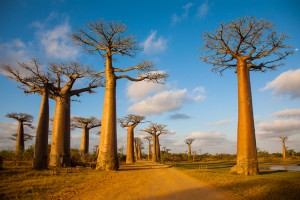Baobabs in Danger
July 26, 2018
The baobab, one of the world’s most unusual and iconic trees, is in danger. The gigantic baobab, known as the “tree of life,” can live as long as 3,000 years. But the hardy trees are suddenly dying in unusual numbers, many long before their expected life spans. Climate change has increased the occurrence of such weather anomalies as droughts, floods, and lightning storms, all of which can harm or kill baobab trees. A destructive mold called black fungus is also appearing more frequently on baobab trees. The tree is further threatened by the loss of its natural habitat to agriculture and development. Habitat loss and illegal hunting have also greatly reduced the population of African elephants, the animals largely responsible for spreading the tree’s seeds. If no action is taken to protect the baobab and its environment, certain species of the tree could be extinct within 100 years.

These giant baobabs form part of the magnificent Avenue of the Baobabs in the Megabe region of western Madagascar. Credit: © Monika Hrdinova, Shutterstock
Baobab is the name of a group of trees that grow in tropical and subtropical regions of the Eastern Hemisphere, especially in Madagascar. The best-known type of baobab is found on the African mainland. It has an extremely thick, often bulging, trunk. This tree may grow to 80 feet (24 meters) tall with a trunk from 30 to 50 feet (9 to 15 meters) in diameter. The tree has white flowers that open at night and are pollinated by bats. The fruit, called monkey bread, is almost 1 foot (30 centimeters) long. It dangles from the tree like a lantern from a long, ropy stem. The fruit holds many seeds buried in a mealy pulp. The pulp, which is rich in vitamin C, serves as food for both animals and people, and it is also used to flavor cool drinks. People sometimes use the leaves and bark in medicines. They make paper, cloth, and rope from the bark fibers. The giant trees also provide shade in the hot climates where they grow, serving as cool gathering places for animals and humans alike.
African elephants, who are themselves in danger, help propagate baobabs by eating the tree’s fruit and seeds (antelopes, baboons, and other animals also contribute). The seeds pass through the animal’s digestive system, and they are then dropped in ready-made fertilizer. Elephants tend to walk great distances in search of food and water, and a single tree’s seeds can thus be spread out over many miles. Ironically, elephants are also known to damage or kill baobab trees in times of severe drought. Elephants sometimes rip apart a baobab’s trunk to get at the tree’s bountiful water supply inside.
Adrian Patrut, a chemist at Babeș-Bolyai University in Romania, has led an international research study on baobab trees since 2005. Patrut pioneered a radiocarbon technique to date baobabs, which do not have the tell-tale age rings found in most trees. Patrut and his team have kept close tabs on the largest and oldest baobabs in southern Africa. They found that 9 of the 13 oldest recorded baobabs (between 1,100 and 2,500 years old) and 5 of the 6 largest have died in the past 12 years—an alarming death rate among these long-living trees. Parts of many other baobabs have also died. The trees have multiple core systems within their massive trunks, allowing parts of the tree to die while the rest lives on.
Of the nine species of baobab trees, six are endemic to the African island of Madagascar. Of those six, half are on the Red List of Threatened Species compiled by the International Union for the Conservation of Nature and Natural Resources (IUCN). The numbers of three Madagascar baobabs—Adansonia grandidieri, Adansonia perrieri, and Adansonia suarezensis—have dropped more than a 50 percent since the 1950′s. A. perrieri and A. suarezensis are considered critically endangered. The numbers of the remaining baobab species that live in mainland Africa, the Arabian peninsula, and Australia are also on the decline.


